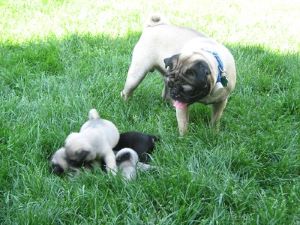
If you’re a dog owner eagerly awaiting the birth of a new litter, seeing your beloved pet eating her own puppies is a shocking experience.
If you’re a breeder, you’re also contemplating significant financial loss.
Then there’s another nightmare scenario – the father killing and eating some or all of the puppies.
You might have heard such awful stories so it’s normal to be worried, but is this a common occurrence?
If you do a thorough search on this topic, you’ll discover that such cases are rare, especially male dogs eating their own offspring. They are however possible and in this article we’ll try to get to the roots of such behavior in both male and female dogs.
Why do male dogs eat their puppies?
One thing you need to know from the very beginning – if you ever come to witness such a horrible thing as a dog killing their own puppies, remember it’s only horrible to you as a human.
Dogs almost always do this for a reason and it probably has to do with their instincts.
When it comes to male dogs, in many cases their role ends after a successful mating. If they don’t live under the same roof with the dam, chances are they won’t even know they sired any offspring.
However, when the two dogs live under the same roof, whether in a house or at a breeder’s farm, there might be a strong attachment between them.
When you introduce the father to the new puppies don’t expect him to be jumping for joy. In most cases, the male dog will manifest mild curiosity or he might simply ignore the puppies.
In rare cases, the proud father might behave aggressively towards his own offspring, even if normally he’s a well-behaved dog.
To understand such behavior, you need to think in terms of canine psychology and instinct that date back ages ago.
One of the main reasons a male dog might attack his own puppies is that he perceives the little ones as unwanted competition.
An alpha dog might want to get rid of other males competing for the favors of a bitch. This sort of behavior is common in other species, like lions, apes, or even cute dolphins.
Do male dogs recognize their puppies?
When a male dog examines the new litter he won’t be quietly going over their features, thinking to himself: ‘Oh, this little fellow has my eyes and the other one the exact same fur as I do!’
Also, there’s nothing in a puppy’s scent to indicate it’s his.
They might perceive them as strangers and potentially dangerous. Even if he did recognize them as his own, a male dog wouldn’t have any qualms about disposing of the new puppy simply because animals are not governed by our moral values.
On the other hand, in a lions’ pride when new males take over they often eliminate the cubs of other males.
One of the most interesting facts about animal behavior towards their young comes from dolphins, generally considered to be very intelligent animals.
Studies have shown that bottlenose dolphins keep track of the females they’ve mated with and their young are safe. However, when a male dolphin runs into a new female accompanied by her young he will kill the calf.
The idea is that once the calf is dead, the mother will go into heat quicker and the male dolphin can get a chance to mate again.
The same theory was proposed for male dogs’ aggressive behavior towards their puppies, but it has been disproved by the fact that female dogs will go into estrus again six months after giving birth no matter if the puppies are dead or alive.
Should the male dog stay away from the puppies?
Puppies don’t really have a need to meet their father or bond with him as in most cases they’ll be sent to a new home and never see their parents again.
Experts believe it’s best if the male dog is kept away from the litter, at least for the first 15 days of the puppies’ lives. There is, of course, the risk the male dog might be aggressive towards the pups, but the older dog might also injure the puppies by accident.
If the dog tries to play with the little balls of fur he might cause them harm totally unintentionally.
At the same time, during the early stages of her pups’ lives the mother herself might behave aggressively when the father comes around, simply because she’s trying to protect her young.
Even when the parents have lived under the same roof for a long time and generally have a good relationship, a young mother is extremely protective of her puppies.
If the tension between the parents escalates, the puppies might get hurt by accident.
It’s safer to have the male dog meet the litter only in the third week. As the puppies start exploring their world, a bit of socializing with their dad might teach them a few things, although this is not absolutely necessary.
Five reasons that female dogs kill their puppies
Once again, this is not common behavior among dogs. However, there are a few types of situations when a dam won’t hesitate to devour some of her young, usually in the best interests of the whole litter.
Let’s have a look at the most common reasons of infanticide in the canine world.
[1] Sick or dead puppies
A whelping dog should be left alone as she’ll know what to do even if it’s a first time mother. It’s called instincts.
A human observer might be aghast seeing the mother eating one or more of her puppies soon after helping them out of the water sac that has protected them in the womb. Often enough there’s no time for the human to intervene and they’ll never know why she did that.
In most cases, however, the puppy was probably stillborn or was doing poorly. After she frees them from the sack, the mother will lick the puppies clean and it is at this time that she might discover the puppy is malformed or sick.
In the animal kingdom there’s no such thing as rushing the newborn to the NICU. Maybe a vet could save a sick puppy, but the dam doesn’t know that. If a puppy is sick, there’s a risk it might infect the other puppies so it needs to be sacrificed.
By doing an awful thing, the mother actually protects the rest of her young. In some cases, when the mother sees one of the pups is sick she’ll push it out of the whelping box, practically abandoning it to its fate.
Also, when you wake up one morning and discover one of the pups is missing, it’s possible that it died of natural causes, like the fading puppy syndrome, and the mother thought it was best to eat it. On the other hand, dams have been known to bury their sick or dead puppies.
[2] Inexperienced mother
Although animals have all the instincts they need to care for their young, a dam might accidentally bite one of the puppies while freeing them from the water sac or cutting their cords.
In both cases, the mother uses her teeth and it’s possible to injure one of them, especially if it is her first pregnancy.
If you see a puppy all bloodied, there’s a chance it was only an accident. At the same time, the mother might freak out seeing all the blood and eat the pup, thinking it has little chance of survival anyway.
[3] Painful nursing
Female dogs can develop mastitis in one or more of her teats. Mastitis is an inflammation of the mammary gland, causing the teat to swell and become bright red or purple if there’s an infection present.
The poor dog is in unbearable pain and she might attack a puppy trying to suckle. To avoid such situations, the owner should always try to inspect the dam’s teats, preferably from a safe distance as this is a time when human interference is not recommended.
See if there are some signs of discomfort while the puppies are suckling and if you believe your dog might have developed mastitis take her to the vet. And bottle-feed the puppies while she recovers.
[4] Stressed out mother
Although this is extremely rare nowadays, a female dog might resort to eating her young if they live in a hostile environment.
A nursing mother needs quiet, a safe place with constant comfortable temperatures and plenty of food to be able to take care of her puppies properly.
Sometimes, a dam might be stressed out if the household is too large or too noisy. If she somehow feels those are not adequate conditions for the puppies to thrive she might think it’s better to kill them altogether.
In the wild, animals do that when resources are scarce.
If there’s not enough food to go around, why waste it on puppies who are more fragile and might not make it into adulthood? Better keep the food for the adult dogs, so they can live and have another litter when conditions improve.
It might look like a very selfish behavior, but it makes sense as far as the survival of the species is concerned.
Incidentally, this type of reasoning might explain historical cases of cannibalism in human societies affected by famine, when the first to be sacrificed were usually the children.
[5] Not recognizing her puppies
Some animals in the wild will refuse to take care of their young if they were touched by humans, usually clueless tourists, as this interaction changes their smell.
Mother dogs have a powerful sense of smell and they’ll recognize both the smell of the puppy and that of any human in the household, so there’s little risk they will abandon or attack the pups if you touch them.
However, there have been cases when a dam attacked her puppies after they were taken to the vet for docking. The mother might consider that the puppy is somehow sick so it’s better to put them out of their misery.
Closing thoughts
Cannibalism in the canine world is uncommon, but not unheard of. A male dog might resort to killing and eating his own puppies if he somehow perceives them as competition.
Also, a male dog might accidentally kill his young by playing too rough with them, which is why he should not be allowed around the new litter for the first two weeks.
On the other hand, when a female dog eats her young she’ll do that either to protect the rest of the litter or to protect herself, like when she develops mastitis and is besides herself with pain. Instead of being horrified, always assume a dam had her reasons to destroy some of the puppies.





